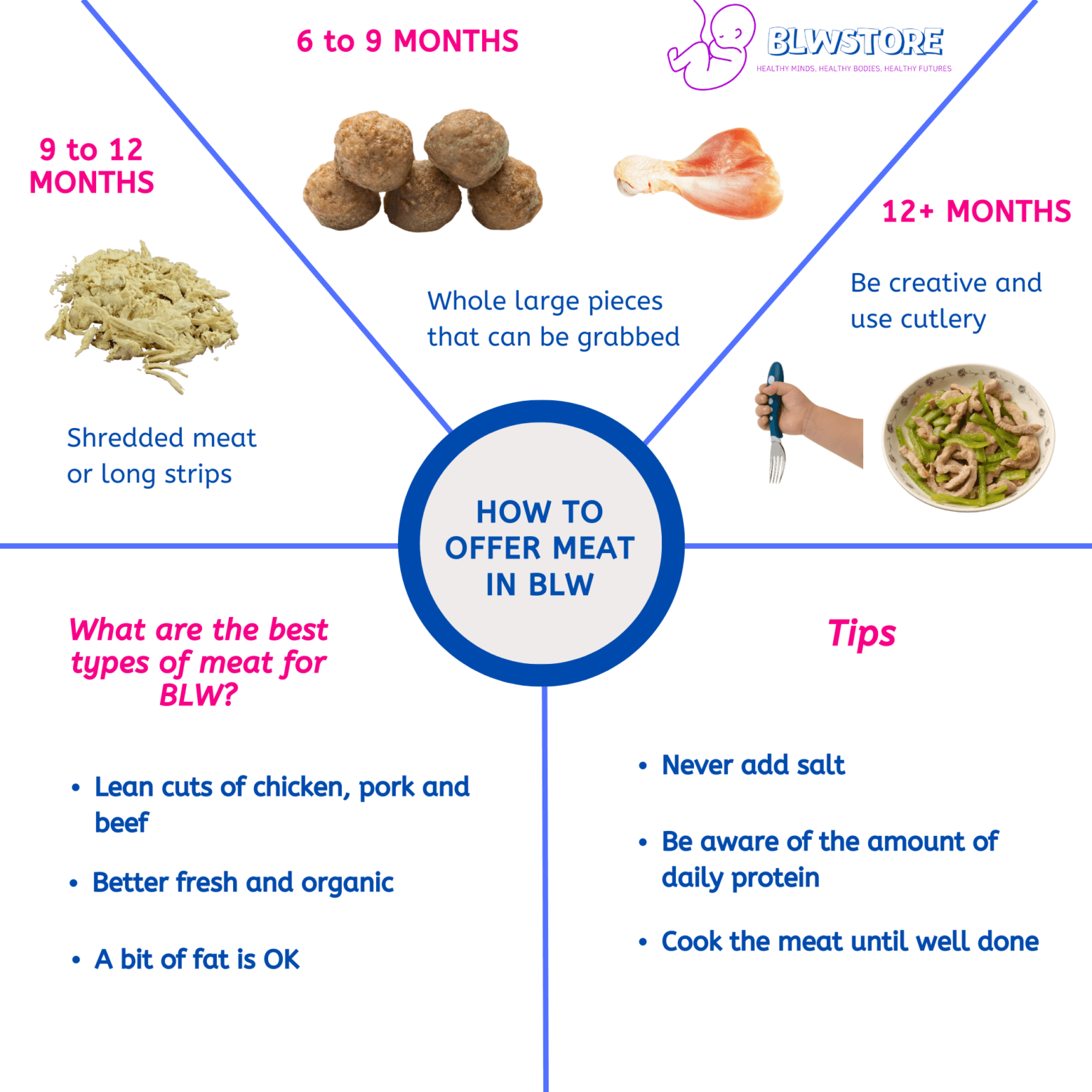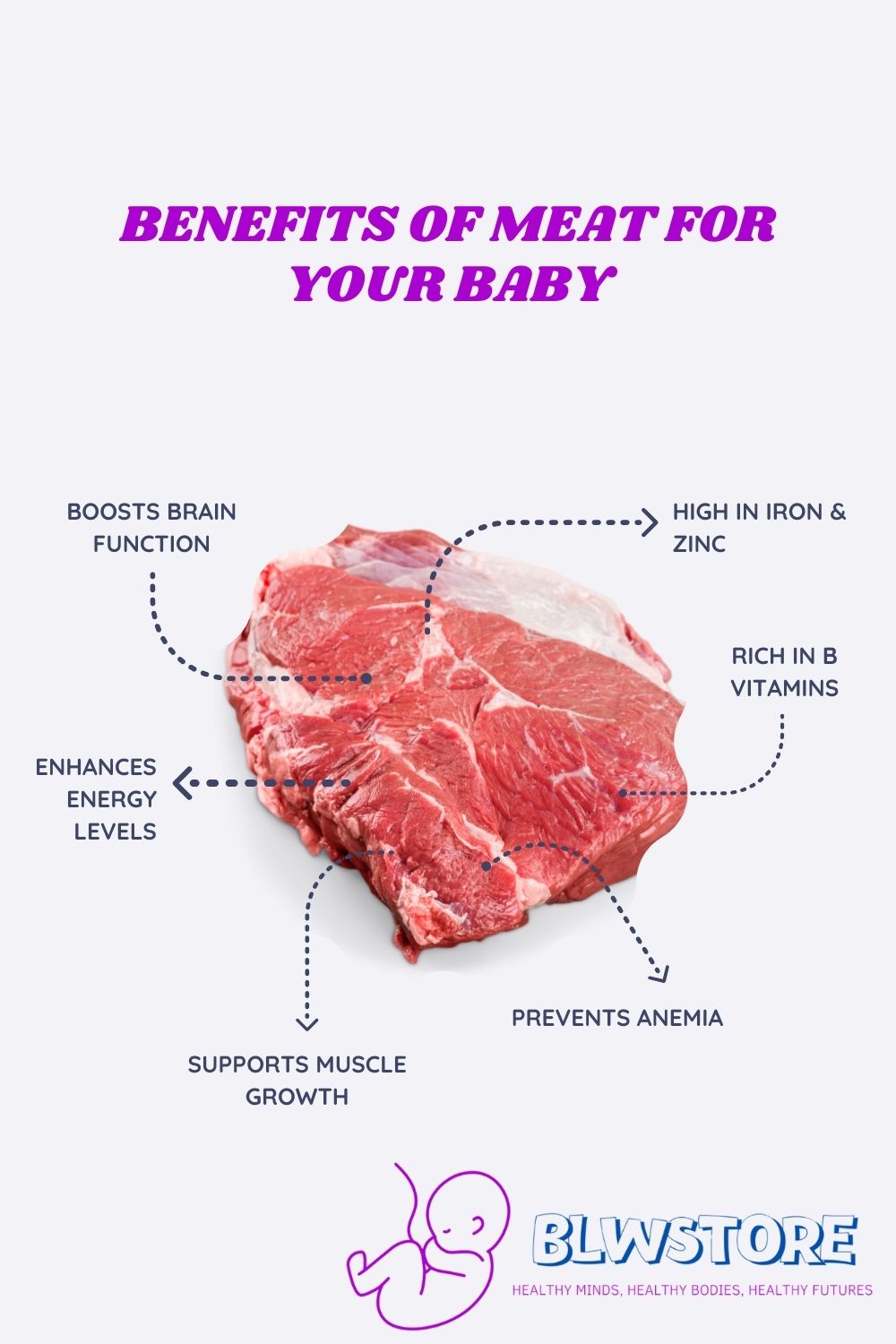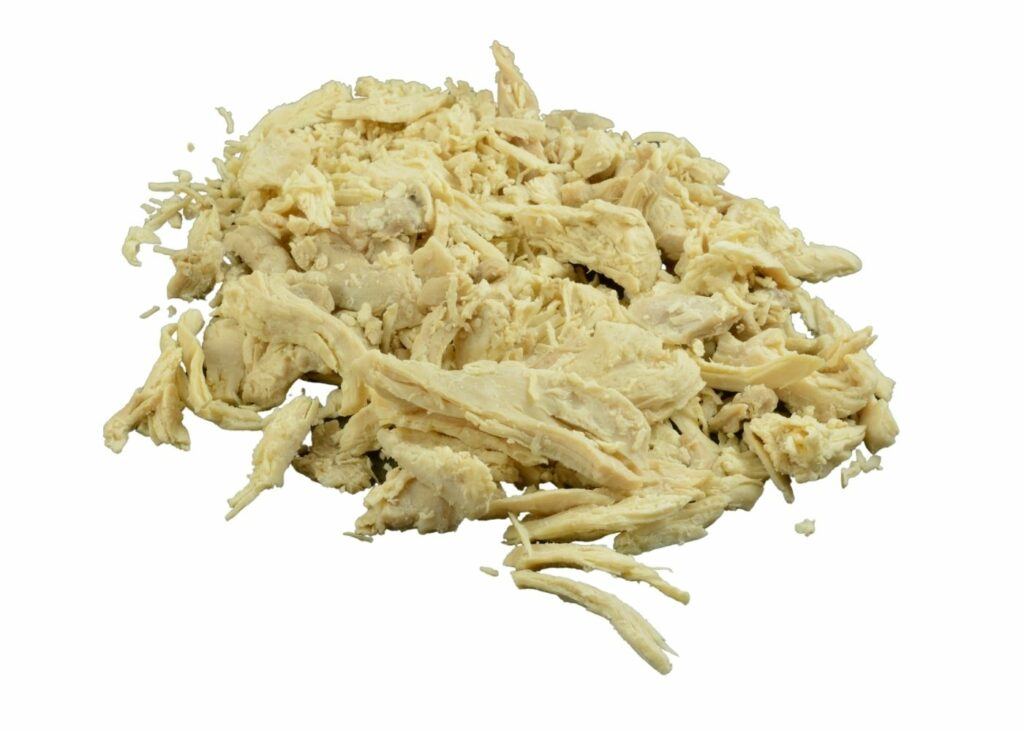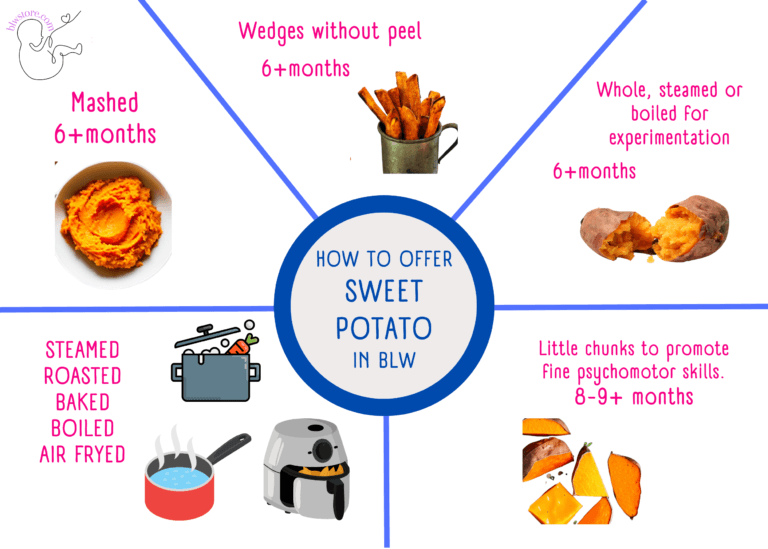
Introducing meat to your baby’s diet can seem complicated, especially following the baby-led weaning (BLW) approach.
Maria and I remember the first time we gave meat to Pablo; it was a chicken meatball with some sweet potato on the side, and we were a bit scared.
But don’t worry; with the proper guidance and precautions, you can safely incorporate nutritious meats such as steak and ground beef into your little one’s meals.
Plus, science says an animal-based diet is more nutritious and has better bioavailability!
Let’s get started!
A word of caution regarding babies and protein
Although protein is a necessary nutrient for a baby’s growth and development, watching how much they eat is crucial.
A baby’s developing kidneys may become overworked by consuming too much protein, which could result in electrolyte imbalances or dehydration.
Furthermore, a diet with too much protein may result in problems with digestion and nutrient absorption, which may result in discomfort or other health issues.
Hence, it is imperative to give your kid a balanced diet that satisfies their nutritional requirements without serving them too much protein.
Here you have a chart with the amount of recommended protein for babies:

Key Takeaways
Introducing meat in BLW can provide essential nutrients, like iron and protein, to support healthy development. However, not overfeeding protein is important to avoid stressing a baby’s developing kidneys.
Babies can start eating meat as early as six months old, following their readiness for solids.
Choose lean, fresh, and organic meats that are easy to chew and digest, and avoid processed meats with high sodium levels and preservatives.
Introduce meat in age-appropriate sizes and consistencies, starting with purees for smaller babies, shredded or minced meat for older babies, and using utensils for babies 12 months and older.
Cook meat thoroughly and safely, avoiding cross-contamination, and do not add salt, sugar, or strong spices.
Get creative with BLW meat recipes, offering a variety of flavors and textures to encourage healthy eating habits.
Benefits of BLW Over Traditional Spoon-feeding Methods
Develops fine motor skills
Encourages independence
Enhances sensory exploration
Supports oral motor development
Prevents overeating
Fosters healthy eating habits
Incorporating meat such as steak or ground beef into your baby’s diet following the baby-led weaning method can offer essential nutrients needed for growth while promoting self-feeding and early exposure to diverse flavors – all contributing factors in raising healthy eaters from day one!
*Learn more about the differences between BLW and purees.
Safety Considerations For Introducing Solid Foods
Proper Food Preparation and Cooking
Cook meat until it reaches the proper internal temperature
Reduces the risk of harmful bacteria
Size and Consistency of Food Items
Offer age-appropriate, soft-textured items
Minimize choking hazards
Clean and Sanitized Surfaces
Cutting boards, countertops, utensils
Serve delicious and safe meals
Supervise Mealtime
Watch for signs of distress or choking
Step in promptly if necessary
| Age Range | Meat Consistency |
|---|---|
| Smaller babies (4-6 months-old) | Purees |
| Older babies (6 months-old) | Shredded or minced |
We recommend starting solids at six months of age. There is no need to start before that.
*Learn more about introducing solids.
When Can Babies Start Eating Meat?
Babies can start eating meat as early as six months old, following the introduction of solid foods through Baby-Led Weaning.
Meat is an excellent source of iron, protein, and other essential nutrients that support healthy development.
It’s also a recommended first food due to its soft texture and easy mashing and pureeing.
It’s also important to start with small portions and gradually increase the amount over time while monitoring your baby’s reaction.
Examples could include trying ground beef or shredded chicken mixed with different spices to introduce new flavors and textures.
Why Meat Is Important For Your Baby

It is High In Essential Nutrients
Meat is a fantastic source of essential nutrients for your baby.
Meat contains high levels of iron, zinc, and protein that are crucial to support growth and development during the early stages of life.
Iron is particularly important for infants as it is critical in carrying oxygen throughout their bodies. Babies who don’t get enough iron may become anemic, leading to developmental delays and lasting effects on cognitive function.
Protein is another essential nutrient in meat that helps build bones, muscles, skin, and other vital tissues in your baby’s body.
Meat also provides your baby with B vitamins such as vitamin B12, riboflavin (B2), niacin (B3), and thiamine (B1). These vitamins help boost energy levels and enhance brain function.
It Supports Brain And Muscle Development
Meat is an excellent source of protein and iron, essential for a baby’s growth and development.
Protein is needed for healthy muscle development, while iron helps support brain function.
Meat contains a particular type of iron that is more readily absorbed by the body than plant-based foods. This makes it particularly important for babies as their bodies are growing rapidly.
Iron deficiency can lead to delayed cognitive development, behavioral problems, and other health issues later in life. Thus, feeding your baby meat during BLW could significantly improve their health.
| Nutrient | Importance for Baby |
|---|---|
| Iron | Critical for carrying oxygen, prevents anemia and developmental delays |
| Protein | Builds bones, muscles, skin and other tissues |
| B Vitamins | Boosts energy and enhances brain function |
What are the best and safest cuts of meat for babies?
Opt for lean meats such as beef, chicken, or pork, as they contain less fat and cholesterol.
Avoid processed meats like hot dogs, sausages, or deli meats with high sodium levels and preservatives.
Select fresh and organic meats free from antibiotics or hormones.
Go for easy chew and digestible tender cuts, like ground beef, minced turkey, lamb chops, or chicken breasts.
Ensure the meat is boneless, skinless, and trimmed off any visible fat before serving it to your baby.
| Meat Type | Protein (per 100g) | Fat (per 100g) | Iron (per 100g) | Calories (per 100g) |
|---|---|---|---|---|
| Chicken | 31 g | 3.6 g | 1.3 mg | 165 kcal |
| Pork | 26 g | 11 g | 0.9 mg | 297 kcal |
| Beef | 26 g | 20 g | 2.6 mg | 250 kcal |
| Lamb | 25 g | 20 g | 1.4 mg | 294 kcal |
| Turkey | 30 g | 1.3 g | 1.1 mg | 104 kcal |
This table shows the approximate amounts of protein, fat, iron, and calories per 100g of the most common types of meat. It’s important to remember that these are average numbers and may vary depending on the cut of meat, cooking method, and preparation.
How Do You Serve Meat In BLW?
6-9 months: Whole pieces that can be grabbed

During this stage, you can introduce large pieces of meat your baby can grab and explore with their hands.
Alternatively, you can grind the meat, mix it with a puree of vegetables like sweet potato or zucchini, and offer it with a spoon. This allows your baby to experience different textures and flavors while getting the essential nutrients from meat and vegetables.
9-12 months: Shredded meat or long strips

Around 8-9 months of age, your baby’s pincer grasp is developing, so you can offer meat in strips or shredded to encourage them to use their fingers to pick up the food.
Another option is to offer smaller pieces of meat, like crumbled meatballs, which are easy for your baby to pick up and eat independently.
12+ months: Utensils time!

When your baby reaches 12 months, it’s a good time to introduce cutlery and offer more diverse recipes and food combinations.
Don’t be afraid to get creative and experiment with different flavors and textures while prioritizing nutritious and varied dishes.
This is a crucial time to establish healthy eating habits to set the foundation for a lifetime of good nutrition.
How Should You Cook Meat In Baby-Led Weaning?
Cooking meat thoroughly and safely is crucial when introducing it to your baby during Baby-Led Weaning.
Follow these steps to ensure that the meat is properly cooked and free from harmful bacteria:
Make sure to cook the meat thoroughly. If you are unsure, you can always use a food thermometer to check the internal temperature of the meat. Beef, lamb, and pork should be cooked to an internal temperature of 145°F (63°C). Ground meat should reach a minimum temperature of 160°F (71°C).
Avoid cross-contamination by separating raw meats from other foods and using separate cutting boards and utensils.
Wash your hands and all equipment thoroughly before handling any meat.
Choose semi-lean or lean cuts of meats as they are healthier for your baby.
- Avoid adding salt or seasonings containing salt, sugar or strong spices.
BLW Meat Recipes And Finger Food Ideas
This section provides you with practical BLW meat recipes and finger food ideas.
Remember that you can always adapt these recipes to your needs, be flexible, and don’t fear trying new things.
Chicken And Sweet Potato Mash (6+months)
Prep time: 15 minutes
Cook time: 30 minutes
Total time: 45 minutes
Yield: 2-3 servings
Ingredients:
1 chicken breast
2 medium sweet potatoes
Instructions:
Cook the chicken breast in a steamer, oven, or pan until tender and fully cooked through. Allow it to cool down before cutting it into small pieces.
Wash and peel the sweet potatoes, then cut them into evenly sized chunks.
Steam or boil the sweet potato chunks until they are soft and easily mashed.
Combine the cooked chicken pieces and mashed sweet potatoes in a food processor or by hand. Blend or mash to create a smooth consistency appropriate for your baby’s age. Add some olive oil and some herbs to add some flavouring.
Note: As your baby grows and learns to chew more effectively, you can gradually decrease the blending time to introduce texture variations.
Serve the chicken and sweet potato mash as finger food and let your baby experiment or offer it with a baby spoon.
Pork Meatballs with Apple for Baby-Led Weaning (8+months)

Prep time: 20 minutes
Cook time: 20 minutes
Total time: 40 minutes
Yield: 2-3 servings
Ingredients:
1/2 lb ground pork
1 medium apple, peeled and grated
1 tablespoon olive oil
A pinch of sesame seeds
1/4 teaspoon dried thyme
1/4 teaspoon dried sage
Salt (optional, for older babies)
Freshly ground black pepper (optional, for older babies)
Instructions:
In a mixing bowl, combine the ground pork, grated apple, seeds, dried thyme, and dried sage. If your baby is older and accustomed to some seasoning, add a pinch of salt and freshly ground black pepper.
Using your hands or a spoon, gently mix the ingredients until well combined.
Shape the mixture into small, baby-sized meatballs.
Heat the olive oil in a non-stick skillet over medium heat.
Carefully place the meatballs in the skillet, ensuring they are not overcrowded. Cook for 8-10 minutes, occasionally turning, until the meatballs are browned on all sides and cooked through.
Remove the meatballs from the skillet and place them on a paper towel-lined plate to absorb any excess oil.
Allow the meatballs to cool down to a safe temperature for your baby before serving.
Serve the pork meatballs with apple as finger food, encouraging self-feeding and developing fine motor skills.
Monitor your baby’s chewing and swallowing closely while they enjoy this tasty and nutritious meal.
Tips:
Make sure the meatballs are cooked thoroughly before serving.
You can adjust the herbs and seasoning to suit your baby’s taste preferences.
If your baby is younger or has difficulty with textures, you can blend the cooked meatballs to create a smoother consistency before serving.

Ground Beef Risotto for BLW
Ingredients
- 1 lb ground beef
- 2 tbsp olive oil extra virgin if possible
- 1/2 tsp dried oregano
- 1/2 tsp dried basil
- 1/4 tsp garlic powder (optional, for older babies)
- 1 cup homemade tomato sauce
- 1 pinch freshly ground black pepper
Instructions
- Heat the olive oil in a large non-stick skillet over medium heat.
- Add the ground beef to the skillet, breaking it up into small pieces with a wooden spoon or spatula.
- Cook the ground beef until it is browned and cooked through, about 8-10 minutes.
- Add the dried oregano, dried basil, and garlic powder (if using) to the skillet, stirring to combine the spices with the cooked ground beef.
- Pour the homemade tomato sauce into the skillet and mix well. If your baby is older and accustomed to a bit of seasoning, you can add a pinch of freshly ground black pepper.
- Reduce the heat to low and let the ground beef mixture simmer for about 10 minutes, allowing the flavors to meld together.
- Remove the skillet from heat and let the ground beef risotto cool down to a safe temperature for your baby before serving.
Notes
- Make sure the ground beef is cooked thoroughly before serving.
- You can adjust the herbs and seasoning to suit your baby’s taste preferences.
- If your baby is younger or has difficulty with textures, you can blend the cooked ground beef risotto to create a smoother consistency before serving.
- Check the baby-friendly tomato sauce in our BLW pasta post.
We’re Maria and Alberto, a married couple and educators who are nutrition enthusiasts. Even before we had kids, we were already crazy about nutrition.
We’d read scientific articles, watch videos from nutritionists, and spend hours listening to nutrition podcasts.
Today, we continue doing this, but in a different way, as we’ve learned to sift through the noise and trends. Nutrition, like any other field of knowledge, the more you read and learn, the more you develop a comprehensive understanding of reality, and that’s what has happened to us.
Before having our first child, we focused on learning everything we could about child nutrition, using the same techniques we had already employed, backed by our extensive knowledge in nutrition.
Our mission is to help other parents with their children’s nutrition, to help them become the best versions of themselves.
If we are what we eat and drink, which is absolutely true, let’s do it right!







